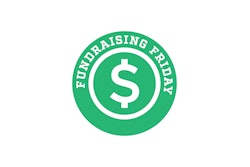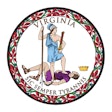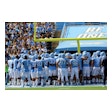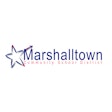Campus Recreation Marketing Has Evolved To Include Some New Promotional Ideas, and a Few Twists on Old Ones
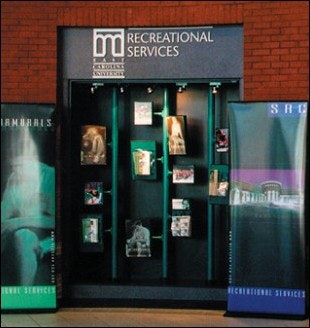
Today in the Student Union: Arm Wrestling Tournament, presented by Anheuser-Busch.
Sound like your typical campus recreation tease? Not in 2002, certainly. But as recently as the early-1980s, brewery sponsorships funded such quirky exhibitions of physical fitness, wrapping them in colorful displays that included glossy banners, slick schedule sheets and championship T-shirts. Back then, the right beer label attached to promotional materials actually brought credibility to collegiate recreational sporting events. "With that brand recognition came a sort of professional look, a professional feel," says Diane Dahlmann, director of recreation services and facilities at the University of Missouri. "Without that, you were left to your own devices."
But times change. Beer sponsorships dried up by 1985. The next 15 years brought a nationwide campus building boom and state-of-the-art student recreation centers. Today, lifelong wellness is in; post-game partying is out (or at least not overtly suggested). And so the vehicles by which college recreation professionals market their facilities, programs and services have changed, too. "As these new student recreation centers open across the nation, departments are operating more like small businesses. They're very focused on customer satisfaction," says Aaron Hill, director of marketing for the National Intramural-Recreational Sports Association (NIRSA). "The skill set that goes along with marketing now applies to campus recreation, as well."
For its part, NIRSA introduced marketing-specific programming at its annual conference in the mid-'90s. By 1997, the organization had responded to growing member demand for an official Marketing Special Interest Subcommittee. The first NIRSA-sponsored marketing symposium took place in 2000, with a second slated for this December. While most in the field agree that campus recreation marketing is evolving, the concept means different things to different people. As Maureen McGonagle, director of campus recreation at DePaul University, says, "What works on somebody else's campus may not work on mine."
To find out what works, one must first identify the goals of marketing campus recreation. Invariably, this means reaching students and other, smaller constituencies with a consistent message that often revolves around enhancing the collective student experience, and promoting individual health and well-being. "One goal is getting the information out to our students as to who we are and what we do," says Nance Mize, director of recreation services at East Carolina University. "Another is doing exciting things to make them want to come back once they know we're here."
The means by which those goals are accomplished vary greatly. What follows are a few of the methods college recreation professionals have found work best:
• Literature. Key to the communications process on any given campus is literature, and a staple on the campuses of most large universities these days is a comprehensive guide to recreation programming and services. Usually published once per term (be it semestrial or quarterly), these publications often number 40 or so pages of newsprint-type stock wrapped in a two- or four-color cover. They are strategically distributed by the thousands anywhere school officials will allow them - in residence halls, dining areas, libraries, student unions and, of course, rec centers. Their cost, at roughly 35 to 40 cents per copy, is a significant departure from the days of plastering a campus with fliers and distributing separate brochures on each program offered. But, according to Dahlmann, who switched to a comprehensive guide based on the logic that students coming from a municipal recreation background are used to having such guides available, the functionality of the larger publications justify their expense. "It's one-stop shopping," she says. "Everything's in there."
Says Jayne DeLuce, associate director in charge of marketing for the University of Illinois' division of campus recreation, "I've consolidated, because when I came here we had a fitness brochure and an intramural brochure and everything all over the place. If someone said, 'Tell me about campus rec,' we had to pull a whole bunch of brochures. Now we have a fall guide, a spring guide and a summer guide, and everything for each season is in that one guide."
Brochures and fliers still have value as an inexpensive complement to other printed materials or to promote special events. At DePaul, an urban commuter campus, the transient nature of students lends itself to more-disposable literature. "Every time students come in they pick up another schedule," McGonagle says. "If that was one big book that cost 10 times more to produce, we'd be having problems." Instead, McGonagle distributes an annual brochure containing information related to facilities and services - such as massage and personal training - that remain consistent in price and scope year-round, as well as quarterly brochures covering programs - including club and intramural sports, and instructional and group fitness classes - that change with the seasons.
Schools may downsize their distributed literature even further in the form of supplemental pocket schedules, which include important dates, times and facility hours. "They're a quick reference," says Mize.
• Facility marketing. Facility marketing is a term used to describe onsite modes of communication that students see but don't physically take with them, and these are becoming increasingly sophisticated. Bulletin boards are giving way to backlit signage, scrolling message boards and computer kiosks, at which students can access recreation information online. This year, East Carolina introduced to its lobby area an 8-foot-tall illuminated transparency that lists all activities for a given month in eye-catching fashion, and for roughly the same cost ($300 per month) as a one-time full-page ad in the student newspaper.
With an even smaller investment, McGonagle has seen great success with a café-style sidewalk sign placed outside the front doors of DePaul's rec center. Heavy pedestrian traffic translates into high exposure; however, McGonagle limits use of the sidewalk sign primarily for special events to keep it from becoming part of the landscape. "People that use the rec center get used to seeing the same old signs, stands and bulletin boards, so sometimes just changing the method of communication can be effective," she says. "If you have a sign up for too long, they don't see it anymore."
McGonagle also warns of facility marketing's inherent limitations, pointing out that even the most eye-catching banners and message boards are seen only by people already using the facility.
• Advertising. Getting the word out to target markets beyond facility walls is critical, but visibility can also be a concern when purchasing newspaper advertising space, according to DeLuce. Since the Daily Illini is distributed free, it depends heavily on ad revenue. Consequently, "it's so concentrated with advertisements that I have to do a half-page ad just to make it visible," says DeLuce, who this semester began purchasing half-page space (at $340 a pop) to run functional clip-and-save calendar ads each month.
Low readership, common among campus newspapers, has caused other rec professionals to think twice before paying for space. Then again, submitting press releases to newspapers in the interest of free exposure doesn't come with a guarantee that the message will be published. Mize became so frustrated with her campus paper's ambivalence to her submissions that she launched her own weekly newspaper devoted to recreation, but that too became cost- and time-prohibitive. She's back to paying for space, and currently budgets a full $15,000 annually for newspaper advertising.
But like Mize, who favorably compares investing in her facility lobby's monthly calendar signage to advertising in the newspaper, DeLuce has found what she considers an equally effective alternative to newsprint. Last fall, students traversing the UI campus by bus noticed something new onboard: colorful 13-by-19-inch posters promoting the recreation division's web site. DeLuce blankets campus bus routes with posters on 75 different buses, at a cost of $125 a month per poster.
• Branding. To gain the attention of students on campus, recreation departments may opt to take advantage of traditional school imagery when choosing everything from logos and icons to color schemes, or come up with their own distinct look altogether.
"Team Mizzou," for instance, is the name given the Missouri recreation department's student-staff leadership and development program, which borrows from the Disney model for selecting and training employees. The name proved so catchy, in fact, that the MU athletic department wanted to use it for a scholarship fund, prompting recreation officials to seek state and federal trademarks. Other brands include "MizzouRec," the identity attached to the entire department, and MizzouRec.com, the address of the department's web site. The brand name "TigerRec" has improved interest in the department's summer sports camps, according to Dahlmann, and "TigerX" (short for Tiger exercise) has replaced "Club Aerobics" as the brand name of the department's aerobics program, which now includes group cycling (in the Cycling Lair, no less) as a major component. "We're drawing more men than ever before," she says, "and we pumped up participation from 850 to 1,300 a semester because we're attracting a broader audience."
The common theme tying these brands together is obvious and by no means accidental. "We know from data and anecdotal evidence collected by other campus departments that students love the black and gold. They love the Mizzou connection," says Dahlmann. "So rather than trotting off in a different direction, we constantly seek to amplify the relationship."
Conversely, the recreation division at Illinois doesn't incorporate school colors or athletic department logos in any of its imagery. "There aren't many campus recreation departments that are totally separate from athletics, but we are," says DeLuce, who adds that in no way does this reflect a desire by the recreation division to distance itself from the school's ongoing American Indian mascot controversy. Designed simply to provide the division with its own identity, a green "swish-dot" logo depicts motion - as if a diver in a vertical, head-long descent - and appears with the words "Division of Campus Recreation" on colorful banners hung outside an otherwise nondescript 30year-old recreation center. DeLuce realizes, however, that this separate identity might require reconsideration if a proposed renovation of the university's rec facilities takes place within the next several years. "When we move to an expanded building, we're going to ask ourselves, 'What's going to be the look that makes it Illinois? Should we identify more with campus?' "
• Events. The popularity of recreation on any given campus may well hinge on impressions made on students during special events. Events held during summer orientation sessions or to welcome first-year students to the start of fall semester set the stage for recreation participation throughout a student's career at the school, and may determine how long that career lasts. "There are lots of retention implications, because the dropout rate is highest during freshman year," says Evelyn Green, associate director of recreational sports at the University of Southern Mississippi. "Recreation is a form of social bonding for them. This is where they can connect and have a sense of belonging. If they find a home away from home, we have a better chance of keeping them."
Mize has lobbied East Carolina administrators to devote a two-hour block of time to a recreation presentation as a required part of the summer freshman orientation schedule, which can mean the difference between 1,000 students attending or only a couple hundred when attendance isn't mandatory, she says. Past themes for the show-like introduction to intramural sports and the like have included "Mission Impossible" and "Survivor." "It gets them in the door," says Mize. "They then know where the rec center is. They know who we are. They know the fun kinds of things that we do. And hopefully when they come on campus in the fall, they'll be back."
Fun is the key word at Illinois during the week students arrive for fall classes, according to DeLuce, who has convinced the UI chancellor's office to include the recreation division's "Fresh Start" as an official event on convocation invitations mailed to more than 6,000 incoming freshmen each summer. The event typically welcomes more than 5,000 new students to a night of live music in the main campus recreation building. "We have demonstrations and stuff going on, but we just want to get them in the building so they get familiar with the fun side of campus," DeLuce says.
Championships represent another type of event that can convert students into repeat recreation customers. These days, it's not uncommon for recreation departments to print game programs featuring player photographs and profiles, and surround title games with amenities such as professional-style scoreboards and upholstered bench seats. Dahlmann labels the backs of courtside chairs with the MizzouRec brand and brings in portable bleacher seating to accommodate crowds of up to 300 spectators. "All of this is very much about what participants want," says Dahlmann, who has removed the word "intramurals" from all recreation department materials to reflect the serious approach taken by rec sports participants. "We decided 'intramurals' really communicates to a student population after-school sports for those who couldn't make the varsity team."
• Face-to-face contact. Among the greatest means by which campus recreation departments can effectively spread their message is through face-to-face contact. "Marketing is all about developing relationships," says McGonagle. "It's not just about information dissemination through written materials. It's actually about making sure people know they can be comfortable talking to you. It's focusing on customer service, so that student employees are giving out better information. Instead of just relying on fliers to deliver the message, it's a bit of the personal touch."
The personal touch was especially important at DePaul, where recreation facilities that amounted to little more than 800 square feet of converted racquetball space gave way to a 120,000square-foot building two years ago. The recreation staff took it upon itself to draft facility tour guidelines, complete with frequently asked questions and their correct answers, and to brief student tour guides dispatched from the university's student affairs office. "People most often learn or get inspired to participate by word of mouth, and we want to make sure that the individuals who have the ears of our target audience have the correct information," McGonagle says.
For those who don't come to the facility to hear the message, the DePaul recreation staff takes the message to them. "It's not fancy, but we do a whole lot of standing up in front of groups," says McGonagle, adding that these groups may include student organizations, as well as faculty members. "Now, not only do they have a slightly better idea of what we do, but they can place a name with a face."
Says DeLuce, "When we did our student referendum efforts, we sent a lot of postcards out, and we posted a lot of fliers in the classrooms and residence halls, but what really was effective was presentations to registered student organizations."
• Evaluation. Determining what's effective and what isn't can be difficult, if measurement tools aren't in place. Regular surveys or focus groups that ask the question, "How did you hear about campus recreation?" or "How did you hear about this particular recreation program?" are widely used to assess the effectiveness of different marketing strategies. "If the students all heard about it by word of mouth, and the faculty/staff all heard about it from fliers, you can target what you're going to do in the future," says McGonagle.
Marketing intelligence can also be gleaned from surveys about specific programming and services, allowing recreation directors to give students what they want. "Our marketing efforts start with deciding what programs and services to offer," says Maureen Kelly, marketing manager for campus recreation at the University of California, Los Angeles. "We listen to our constituency constantly about what the hot fitness classes are, what the popular sports are, and adjust accordingly." Adds Green, "Don't offer yoga just because you're good at yoga."
"We ask them critical things: 'What do you think of our officiating?' 'Have you participated before?' 'Is it better?' 'Is it worse?' " says Dahlmann, who has students grade programs on a system they're familiar with - a four-point scale. "It tells us fairly accurately how the product is doing in the eyes of the consumer on campus."
The methods may be evolving, but reaching students with an effective marketing message remains a daunting task. From the moment they set foot on campus, college students are bombarded with marketing messages and entertainment options. It's easy to see how organized sports participation and exercise can get lost in the clutter. "Our competitor is not necessarily that gym across the street," Green says. "Our competitor could be a Game Boy."
"You know what our biggest competitor is. Time," says Kelly. "When we ask people to sign up for a class, most aren't worried about the cost; they're worried about committing to eight weeks. We need to get to students and say, 'This is really worth your while, because it's going to make you feel good.' We hope that when they come through the door and take that fitness class, the experience is good enough for them to come back and take the next one. We get them hooked on it."

















